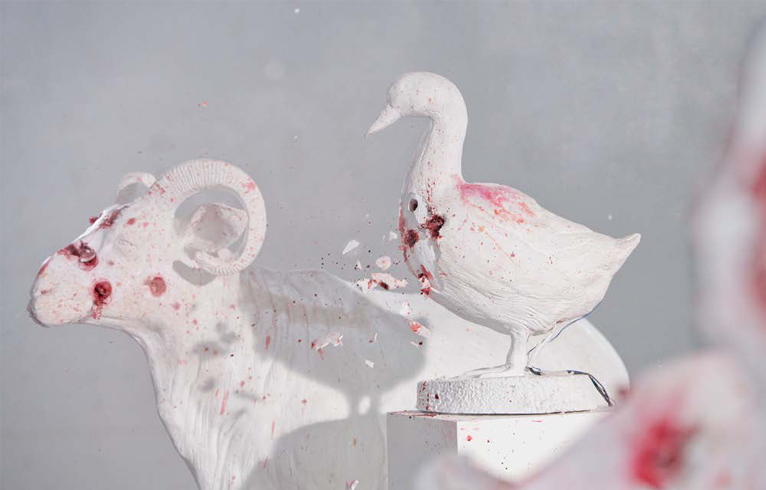ZHANG DING: BUDDHA JUMPS OVER THE WALL
| October 26, 2012 | Post In LEAP 16

The most eye-catching spectacle of Zhang Ding’s “Buddha Jumps over the Wall” can be found atop two monumental metal columns; a lean man, holding a knife and a gun, on a ritualistic platform such that to see him we have no choice but to look up. The subjects of video-looped “sacrifice” must either directly face the muzzle of his gun or lie prostrate at his feet. In the inner exhibition hall, a red carpet and a large painting together constitute a structuralized, solemn spatiality. The painting shares elements with the Garden of Eden; a not particularly sexy nude female in profile emerges out of a jagged, thistly grove, her naked flesh rolled up into a red-and-white life preserver. The perspective gives the impression of a 3D digital drawing, but closer examination reveals mere acrylic. Most importantly, a section of the painting also makes an appearance in the exhibition space: a bizarre roofless “pavilion”— with no ornamentation save the oyster shells atop its pillars— is home to a red-and-white life preserver, sliced open next to a tree branch that stretches into the sky.
Zhang Ding can never abandon his mastery over place: the exhibition must be lively and magnificent, done just so, and dripping in abundance. The paintings, the installations, the videos, those who engage, those who observe, those present and those leaving— everything must interact, whether through the solemnity of the site or through its intermingling of truth and falsehood. Zhang need only sigh to arouse all five of the senses; he possesses the ability to transmit the “itch” to everyone present. A group of skinny boys and girls waltz on the red carpet, and in the pavilion an orchestra of young girls pluck and sing away. Mouth-watering aromas waft past as two master chefs fix up abalone, sea cucumber, and numbing peppercorn nearby (some of the key ingredients of “Buddha Jumps over the Wall,” the famous dish after which the exhibition is named). The intensity of this ambiance takes full control over the space, seeming to drown out the sound of gunfire in its all-consuming wake. Five obedient and loveable plaster animals— the primary ingredients of this rendition of “Buddha Jumps over the Wall”— are poised to slide down the crowd’s proverbial throats at our beck and call, and in the short film provided, behold: smiling as they take two or three bullets each, and then, that satisfying boom of the final shot to send their flesh and guts flying.
In contrast to Zhang’s film Great Era, which privileges narrative, scene, and props, the imagery here is more simplistic. But at the same time, it is all there: joyful, sincere, and powerful background music, inlaid in each instant of bullet-to-flesh-to-blood-spout; close-ups and poetry; and the painstaking intentionality of the camera as it further fans the flames, like one slap after another to your face, refusing to let up until you weep for mercy. A few lines from the Tang poet Li He seem to make even more sense in the present. In his lifetime, Li went to great lengths over his fascination with the ghostly, demon-like aura of culinary delights; the utmost in extravagance and waste was intimately connected to the extremes of terror. But today, who suffers from that sort of fear? Turning to look once again at the table, lined with its exquisite soups alongside the “residue” of animal explosions, everybody is at ease, lounging around sipping nectar. It is grotesquely fantastic, an absurd scene and a bizarre surprise, but completely familiar within the Chinese context. Most interesting is the sculpture’s outstretched hand, reaching out to “welcome visitors” into the banquet hall. The halo above it performs quite the magical feat. On the one hand, there you see him, the hunter and butcher, very clearly raising his gun. But then, over there, his shadow on the opposite wall stands at attention, hands at his side: a true, modest gentleman.
Yuan Jing (Translated by Katy Pinke)

